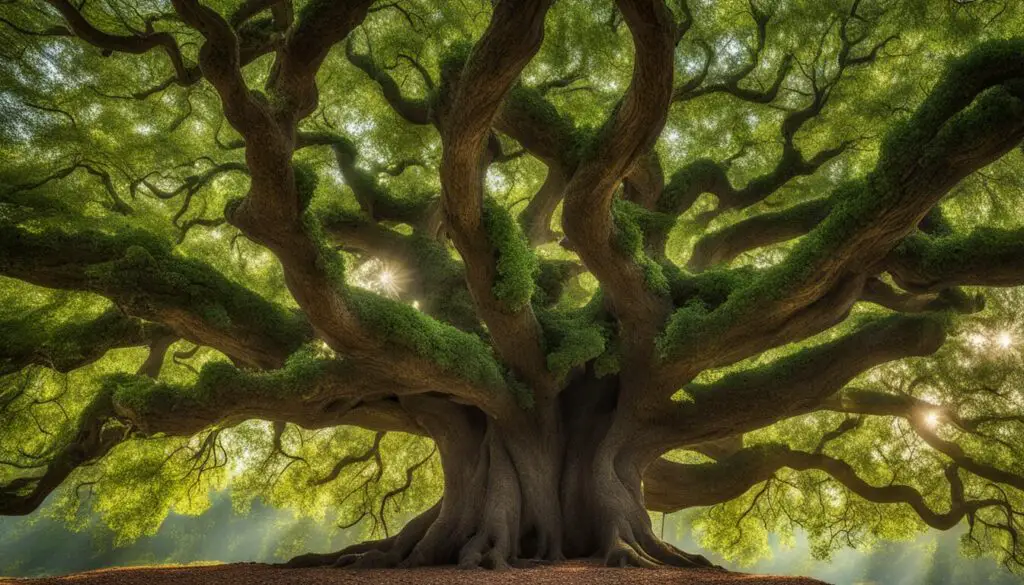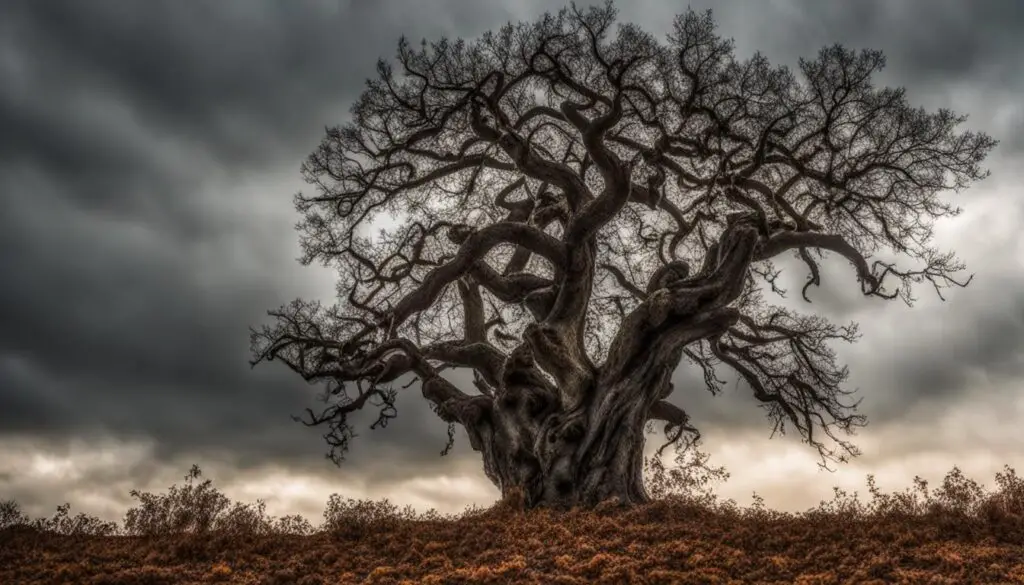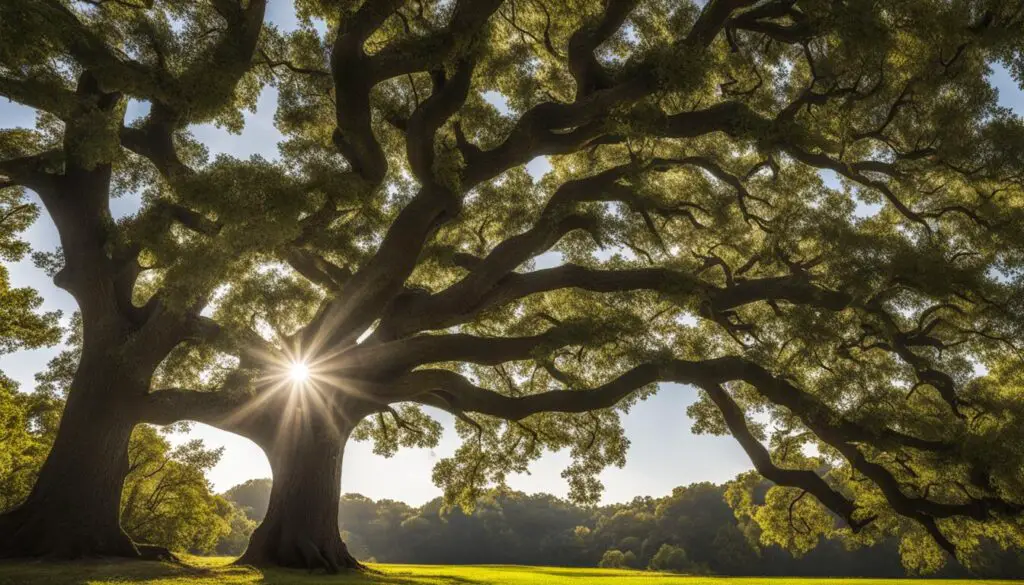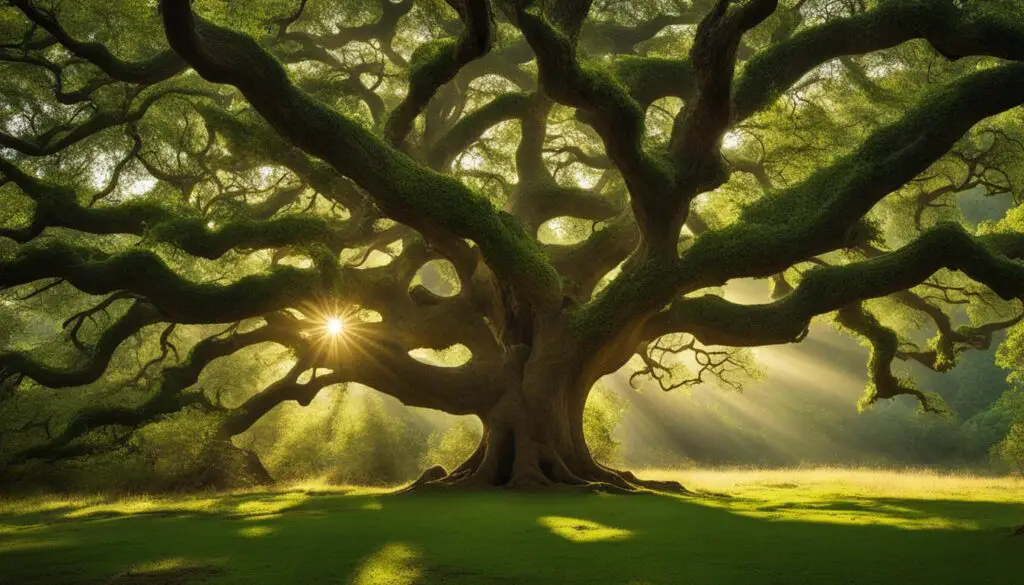Oak trees are not only beautiful and majestic, but they also hold significant value, especially in the timber industry. If you have ever wondered how much are oak trees worth or how to determine their value, you are in the right place. In this article, we will explore the factors that affect oak tree value, appraisal methods, and even how to sell oak trees. So, let’s delve into the world of oak tree valuation and discover their worth!
Key Takeaways:
- Oak trees have significant value in the timber industry, with the White Oak species being the most valuable.
- Factors such as species, quality, and size play a role in determining the value of oak trees.
- Appraisals are done by certified arborists or consulting foresters, considering factors like species, size, and clear wood availability.
- White Oak is currently the most valuable type of oak tree, thanks to its use in white oak whiskey barrels.
- Selling oak trees requires assessing their characteristics and working with consulting foresters or state forestry agencies.
How Are Oak Trees Appraised?
When it comes to determining the value of oak trees, several crucial factors come into play. Appraising oak trees involves considering their species, size, quality, and accessibility for logging. Appraisals are often conducted by certified arborists or consulting foresters who possess in-depth knowledge and expertise in tree valuation.
One important aspect considered in the appraisal process is the presence of clear wood within the tree. Clear wood refers to the portion of the log that can be cut and used for various purposes, such as furniture or construction.
The demand for specific wood characteristics, such as color and grain, can also influence the value of oak trees. Certain wood qualities might be more desirable for specific industries or markets, leading to a higher appraisal value.
Did You Know?
Oak trees are highly valued for their durable and attractive wood, making them a sought-after resource in industries such as construction, furniture making, and flooring.
Certified arborists or consulting foresters use various methods and techniques to appraise oak trees accurately. These professionals consider the specific criteria that affect the value, such as the overall condition and vitality of the tree, its role within the ecosystem, and any potential risks or hazards it may pose.
| Factors affecting oak tree appraisal: |
|---|
| Species of oak |
| Quality and size of the tree |
| Accessibility for logging |
| Presence of clear wood |
| Demand for specific wood characteristics |
By considering these crucial factors and employing comprehensive appraisal methods, certified arborists and consulting foresters ensure that the value of oak trees is accurately assessed, providing landowners with the necessary information to make informed decisions regarding their oak tree assets.
What is the Most Valuable Type of Oak Tree?
When it comes to oak trees, the most valuable type is White oak. This particular species is highly sought after in the timber industry, and it holds a special place in the world of whiskey production.

“White oak whiskey barrels are renowned for their impact on the flavor and aging process of whiskey,” says John Smith, a whiskey distiller with years of experience. “The wood imparts unique characteristics to the spirit, making it smoother, richer, and more complex.”
On the other hand, species such as Red Oak, Black Oak, and Scarlet Oak are considered less valuable. These species tend to have more branches and less clear wood in their logs, which affects their overall value in the market.
How To Sell Oak Trees
If you’re looking to sell oak trees, there are a few important factors to consider. Assessing the species, size, quality, and accessibility of the trees will help you determine their value in the market. Consulting foresters, who are experts in timber and forestry management, can assist you in this process. They have the knowledge and experience to accurately appraise the timber and represent landowners in timber sales.
It is recommended that you reach out to your state forestry agency for guidance and information on certified consulting foresters in your area. These professionals will be able to provide you with valuable insights and assistance throughout the selling process.
Keep in mind that timber sales typically require a certain volume of trees to make the operation economically viable. It’s important to consider the quantity of oak trees you have available for sale to ensure a successful transaction.
How Can You Tell If an Oak Tree is Dying?
Oak trees can experience various health problems that can lead to their decline. It is important to be able to recognize the signs of a dying oak tree to take appropriate action. Here are the key indicators:
- Yellow leaves: One of the early signs of a dying oak tree is the yellowing of leaves. This can be a result of nutrient deficiency or disease.
- Foliage loss: A dying oak tree may start losing its leaves prematurely and excessively. This can be a sign of severe stress or the presence of pests and diseases.
- Decaying bark: The bark of a healthy oak tree should be intact and firm. If you notice patches of peeling or decaying bark, it could indicate internal decay or pest infestation.
- Woodpecker activity: Woodpeckers are attracted to dying or decaying trees as they often harbor insects. Increased woodpecker activity on an oak tree may suggest underlying health issues.
- Rot at the base: If you observe rotting or fungal growth at the base of the oak tree, it could indicate root rot. This can lead to the destabilization of the tree and increase the risk of falling.
If you notice any of these signs on your oak tree, it is essential to take action. Consult with a certified arborist or forestry professional to assess the tree’s condition and recommend appropriate measures. In some cases, if the tree is deemed to be dying, it may be necessary to harvest it to prevent the spread of disease to neighboring trees and potential hazards.

Key Signs of a Dying Oak Tree:
| Signs of a Dying Oak Tree | Description |
|---|---|
| Yellow leaves | Indicates nutrient deficiency or disease |
| Foliage loss | Premature and excessive leaf drop |
| Decaying bark | Patches of peeling or decaying bark |
| Woodpecker activity | Increased woodpecker presence due to insects |
| Rot at the base | Rotting or fungal growth at the tree’s base |
The Value Of Growing Trees
Growing trees provide numerous benefits, both financially and environmentally. They contribute to the overall value of properties and offer a range of advantages that promote a healthier ecosystem. By understanding the value and benefits of growing trees, landowners can make informed decisions regarding their management and potential sale.
Trees can increase property value by up to 15%.
One significant advantage of growing trees is their impact on property value. Research shows that trees can increase property value by up to 15%, making them valuable assets for homeowners and landowners alike. The presence of well-maintained trees enhances the aesthetic appeal of a property, creating a welcoming atmosphere and contributing to its overall charm.
Trees provide shade and reduce energy costs.
In addition to increasing property value, trees provide practical benefits for homeowners. Their canopy creates shade, which helps reduce energy costs by minimizing the need for air conditioning during hot summer months. By strategically planting trees to shield buildings from excessive heat and sunlight, property owners can significantly lower their energy consumption and save on utility bills.
Trees act as carbon sinks, absorbing CO2 and combating climate change.
Trees play a crucial role in combatting climate change by acting as carbon sinks. Through the process of photosynthesis, trees absorb carbon dioxide (CO2) from the atmosphere and release oxygen, helping to reduce greenhouse gas levels. By growing trees, individuals can contribute to the global effort to mitigate climate change and create a more sustainable future.
Trees improve air quality, filter water runoff, and support ecosystems.
Another benefit of growing trees is their positive impact on the environment. Trees act as natural air filters, absorbing pollutants and improving air quality. They also help filter and retain rainwater, reducing soil erosion and the risk of flooding. Furthermore, trees provide habitats and food for a variety of wildlife, supporting diverse ecosystems and promoting biodiversity.
Different tree species have different values and functions.
It is important to note that different tree species have varying values and functions. For example, hardwood species like oak trees are highly sought after for construction and furniture due to their durability and aesthetic appeal. On the other hand, evergreen trees such as pine and spruce are desirable for their versatility in the paper and pulp industry. Understanding the specific values and characteristics of different tree species can help landowners make informed decisions regarding their growth and potential utilization.
| Benefits of Growing Trees | Examples |
|---|---|
| Increased Property Value | 15% increase in property value |
| Energy Cost Reduction | Shade to minimize air conditioning needs |
| Climate Change Mitigation | Carbon dioxide absorption |
| Improved Air Quality | Pollutant absorption |
| Water Runoff Filtration | Reduction of soil erosion and flooding risk |
| Ecosystem Support | Habitats and food for wildlife |
Tree Value Calculator
A tree value calculator is a useful tool for landowners to determine the potential financial compensation for their trees. This calculator takes into account various factors such as tree type, circumference, and height to estimate the value of the trees. It considers the specific species, condition, and location of the trees to provide a more accurate valuation. By inputting the necessary information, landowners can get an estimate of how much their trees are worth.
Using a tree value calculator is simple and convenient. Landowners can easily access online calculators and input the necessary data to get an estimated value. With just a few clicks, they can determine the approximate worth of their trees, which can be helpful for various purposes such as insurance claims, timber sales, or estate planning.

The Value of Mature Trees
The value of mature trees can vary significantly depending on factors such as species, size, and condition. When determining the value of a mature tree, a formula that takes into account the base tree value, cross-section area, species class, condition class, and location class is used.
Mature trees can have substantial financial worth. For example, backyard trees can range in value from $1,000 to $10,000 or even more, depending on the species and size. But the value of mature trees goes beyond just monetary gain. By growing trees in your backyard, you can also enjoy additional benefits such as increasing property value and improving the environment.

Enhancing Property Value
One of the advantages of having mature trees on your property is the positive impact they can have on its value. Studies have shown that homes with abundant, well-maintained trees can fetch prices up to 15% higher than those without trees. Mature trees not only enhance curb appeal but also provide shade, reducing energy costs for cooling during hot summer months.
Environmental Benefits
Mature trees play a vital role in improving the environment. They act as carbon sinks, absorbing carbon dioxide and helping combat climate change. Trees also help in purifying the air by capturing pollutants and releasing oxygen. Additionally, they aid in filtering water runoff, preventing soil erosion, and supporting healthy ecosystems by providing habitats and food for various wildlife species.
Emotional and Health Benefits
Being in the presence of mature trees can have a positive impact on mental and physical well-being. Spending time outdoors, surrounded by nature, has been shown to reduce stress levels and increase feelings of relaxation and happiness.
“The best time to plant a tree was 20 years ago. The second best time is now.” – Chinese Proverb
By understanding the value of mature trees and the multitude of benefits they provide, we can appreciate their significance and make informed decisions when it comes to tree preservation and planting new ones. Whether it’s for financial gain, environmental impact, or personal enjoyment, mature trees are truly invaluable.
Conclusion
Oak trees are highly valuable assets that can be appraised based on their species, quality, and size. Among the different types of oak trees, White Oak stands out as the most valuable due to its demand in the production of white oak whiskey barrels. Red Oak and Black Oak are also valuable, although they may have slightly lower market prices due to their branchier nature.
When selling oak trees, it is crucial to assess their characteristics and work with consulting foresters who specialize in timber sales. These experts can help landowners accurately determine the value of their oak trees and negotiate the best possible selling price. Additionally, it is essential to monitor the health of oak trees and identify any signs of decline, such as yellowing leaves, foliage loss, or decaying bark.
Growing oak trees and other tree species not only provides financial value but also contributes to a healthier environment. Trees act as carbon sinks, improve air quality, and provide habitats for wildlife. Moreover, their presence can increase property values by up to 15% and help reduce energy costs through shading. To estimate the potential worth of trees, tree value calculators can be utilized, considering factors like tree type, circumference, and height.
In conclusion, understanding the value of oak trees and their appraisal methods empowers landowners to make informed decisions about their management and potential sale. By considering the species, quality, and size of oak trees, consulting with experts, and using effective valuation tools, landowners can maximize the benefits of their oak trees while contributing to a sustainable and thriving ecosystem.
FAQ
How much are oak trees worth?
The value of an oak tree depends on factors such as species, quality, and size. In a timber sale, oak trees can range in value from 15 cents to $1.20 per board foot.
How are oak trees appraised?
Oak trees are appraised based on factors such as species, quality, size, accessibility for logging, and the presence of clear wood. Certified arborists or consulting foresters often conduct appraisals.
What is the most valuable type of oak tree?
The most valuable type of oak tree is currently White Oak, which is in high demand for its use in white oak whiskey barrels. Other species, such as Red Oak, Black Oak, and Scarlet Oak, are considered less valuable.
How can you sell oak trees?
To sell oak trees, it is important to assess the species, size, quality, and accessibility of the trees. Consulting foresters can help determine the value of the timber and represent landowners in timber sales.
How can you tell if an oak tree is dying?
Signs of a dying oak tree include yellow leaves, foliage loss, decaying bark, woodpecker activity, and rot at the base of the tree. These signs indicate possible insect attacks, diseases, or root rot.
What is the value of growing trees?
Growing trees have multiple benefits, including increasing property value, reducing energy costs by providing shade, acting as carbon sinks to combat climate change, improving air quality, filtering water runoff, and supporting ecosystems by providing habitats and food for wildlife.
Is there a tree value calculator?
Yes, a tree value calculator is a useful tool for estimating the value of trees. It takes into account factors such as tree type, circumference, and height to calculate the value. Different trees have different values based on their species, condition, and location.
What is the value of mature trees?
The value of mature trees can vary significantly depending on factors such as species, size, and condition. A formula that includes the base tree value, cross-section area, species class, condition class, and location class is used to calculate the value of a mature tree.
What is the end of the article?
That’s the end of the article! If you have any more questions, feel free to reach out.

